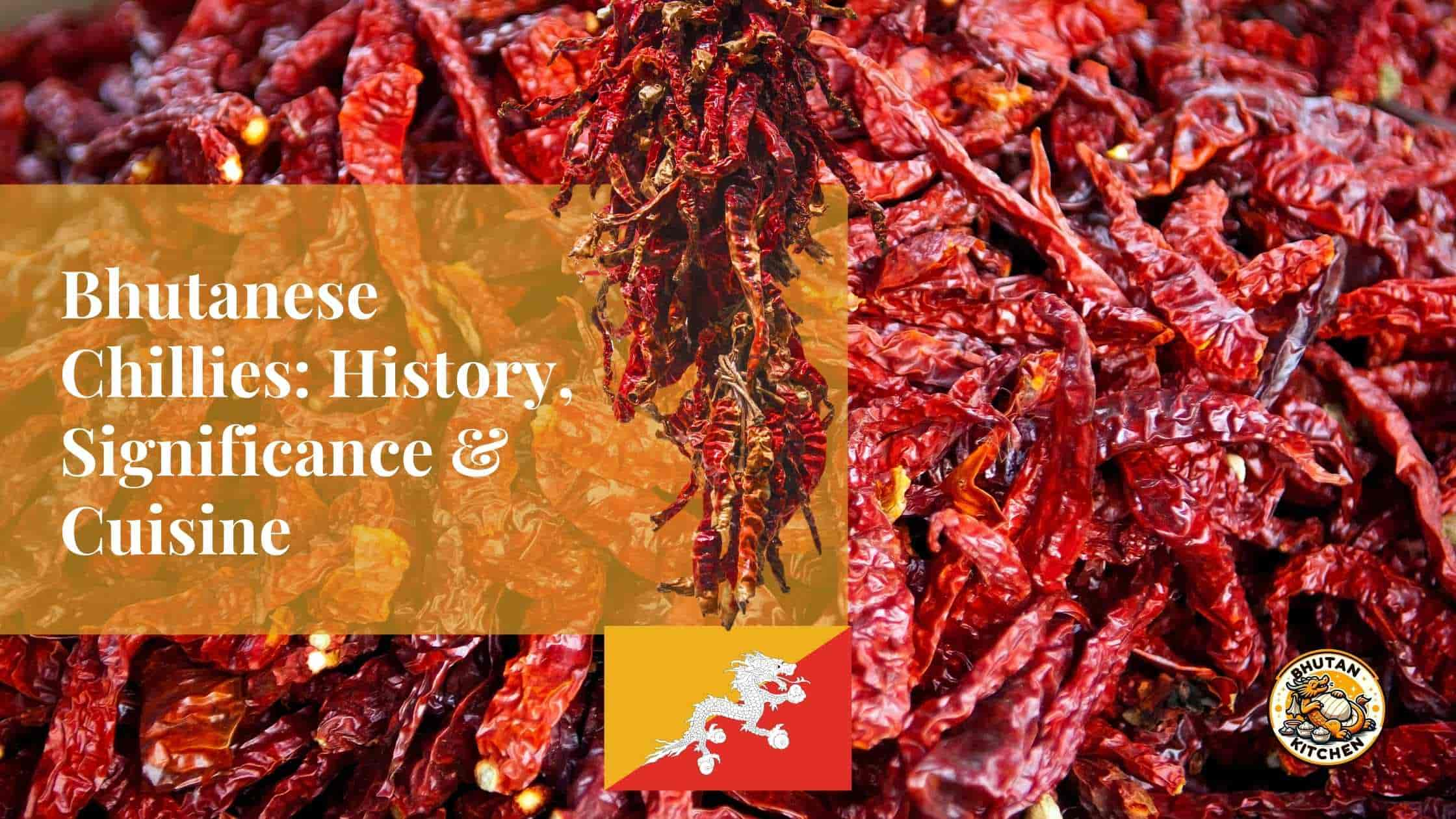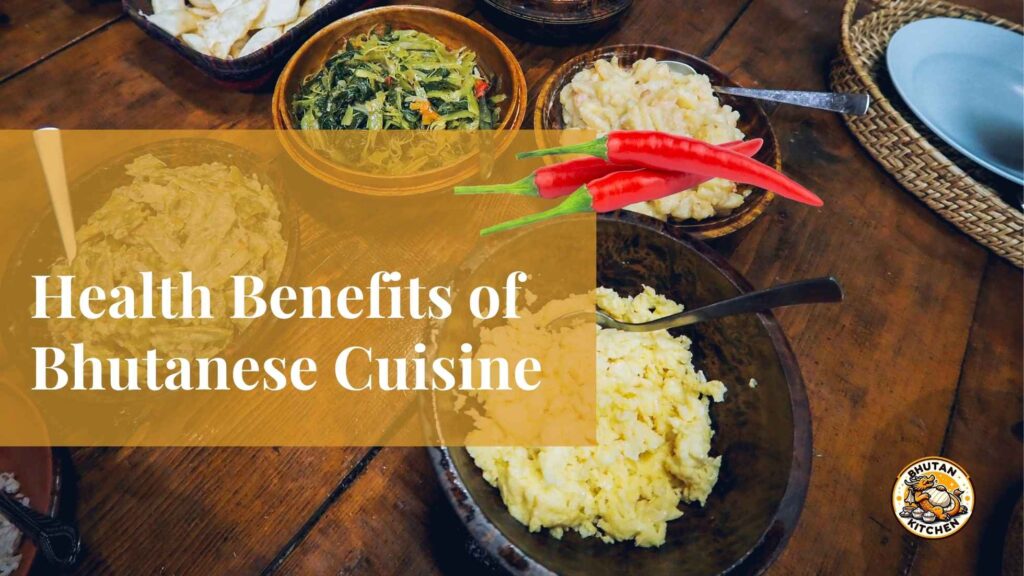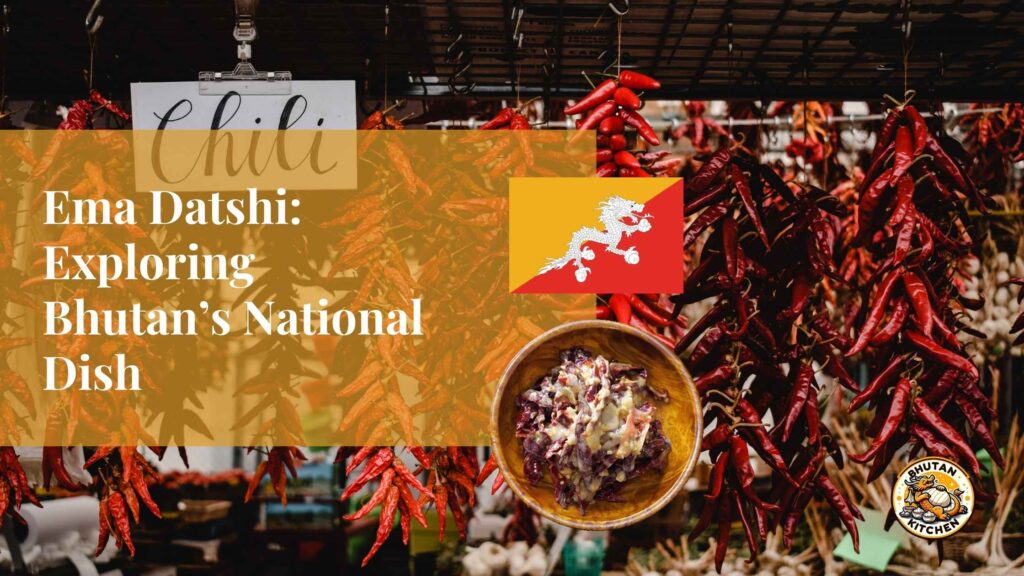Bhutan, a small Himalayan kingdom nestled between India and China, boasts a unique culinary heritage that mirrors its breath-taking landscapes and rich culture. Central to Bhutanese cuisine is the humble chilli, known locally as “ema,” which is not merely a spice but a defining feature of the nation’s gastronomic identity. In Bhutan, chillies are consumed in astonishing quantities with the average household eating more than one kilogram of chilli peppers per week, which means the highest per-capita consumption of chilli in the world. In other words chillies appear in nearly every meal, from soups to side dishes and condiments. In this article we will cover the history of the Bhutanese Chilli, it’s significance and how it shaped the culinary landscape.
Historical Journey of Chillies in Bhutan
Chillies, though now a staple in Bhutanese cuisine, were not native to the region. Chillies were introduced to Bhutan from India around the 16th century, marking a significant shift in the culinary landscape of the country. Prior to their introduction, Bhutanese cuisine primarily relied on local herbs and plants for flavouring. The cold climate of Bhutan made the consumption of spicy food not just a preference but a necessity for warmth, leading to the rapid integration of chillies into everyday meals.
By the 18th century, chillies had become a staple in Bhutanese cuisine, with their presence noted in various traditional dishes. The national dish, Ema Datshi, which consists of chillies and cheese, exemplifies the deep-rooted love for this ingredient. The Bhutanese use chillies more as a vegetable than a spice, which is a unique aspect of their culinary culture.
Additionally, the historical significance of chillies extends beyond mere consumption; they have been noted in the Tibetan pharmacopoeia around 1750, indicating their recognized value in traditional medicine and cultural practices. This historical context highlights how chillies have become intertwined with Bhutanese identity, reflecting both the practical needs of the environment and the cultural evolution of the nation.
About the Bhutanese Chilli
In Bhutan, chillies are not only a spice but also a vital vegetable, integral to the national diet. They are consumed in various forms—fresh green, dried, and powdered—making them a staple in nearly every meal (Ueda and Samdup, 2009). The crop is cultivated across all districts, with farmers in major chilli-growing areas earning a substantial income from their sale. As per a study by Dorji in 2009, the high potential return on chilli cultivation is achieved in a relatively short period, making it an attractive crop for local farmers.
Chilli production in Bhutan has shown impressive figures, with 13,606 metric tonnes recorded in 2017 from a cultivation area of 7,571 acres. This results in an average yield of 1,797 kg per acre, marking it as the highest cultivated vegetable in terms of area, second only to potatoes.
Varieties of Bhutanese Chillies
Bhutan is home to several chilli species, including Capsicum annuum L. , Capsicum frutescens L. , Capsicum pubescens Ruiez. & Pav. , and Capsicum baccatum L. (National Biodiversity Centre, 2015). Among these, three major varieties have been officially released, while numerous landrace varieties thrive in different regions, each adapted to local environmental conditions.
- Sha Ema:
- Region: Wangdue Phodrang
- Description: This variety features elongated, wrinkled pods and is known for its mild pungency, making it a popular choice for traditional dishes like Ema Datshi.
- Nubi Ema:
- Region: Trongsa
- Description: Similar in shape to Sha Ema, this variety has a slightly hotter flavor profile, adding depth to various curries and stews.
- Kangpara Ema:
- Region: Trashigang
- Description: This variety is recognized for its vibrant color and robust flavor, often used in pickles and as a fresh garnish.
- Pakshikha Ema:
- Region: Chukha
- Description: Known for its heat, this chilli is commonly used in spicy dishes, enhancing the overall flavor profile.
These landrace varieties are cultivated from seeds stored from previous seasons, although the lack of proper seed production methods may lead to cross-pollination, affecting their phenotypic and genotypic characteristics. Despite this, they provide a vital source of genetic diversity for plant breeding, and conservation efforts are encouraged to maintain their unique traits.
The Dalle Khursani Chilli, known as the “fireball,” is not for the faint-hearted. Generally grown in the south of Bhutan this little chilli is one of the hottest in the world with between 100,000 and 350,000 SHU (Scoville heat units), which is similar to a Habanero chilli pepper.
Economic and Cultural Significance
The economic returns from chilli cultivation are significant, with farmers benefiting from the sale of both fresh and dried chillies. The high demand for chillies in Bhutanese cuisine not only supports local livelihoods but also preserves cultural heritage. Studies by Ghimiray in 2005 have identified 18 accessions of Capsicum annuum L. collected from various regions, highlighting the rich genetic diversity available for future crop improvement initiatives.
Ritualistic Uses
Chillies also hold a revered place in Bhutanese traditions and rituals. Their vibrant red colour and pungent aroma are believed to have protective qualities. Burning chillies is a common practice in Bhutanese households to ward off evil spirits and negative energy. This ritualistic use underscores the multifaceted role of chillies in Bhutanese culture, blending the practical with the spiritual.
Ema Datshi: The National Dish
Among the many Bhutanese dishes featuring chillies, Ema Datshi holds a special place as the national dish. This simple yet iconic recipe combines chillies—either fresh or dried—with locally made cheese, creating a creamy, spicy stew that is a staple in Bhutanese households. Ema Datshi epitomizes Bhutan’s love for chillies, offering a bold and satisfying flavour that appeals to locals and visitors alike. Variations of this dish, such as Kewa Datshi (with potatoes) and Shamu Datshi (with mushrooms), highlight the versatility of the core ingredients while maintaining the distinct heat and texture. Read all about Ema Datshi here.
Other Traditional Dishes
Chillies are also central to other Bhutanese delicacies. Phaksha Paa, a flavorful dish made with pork, dried red chillies, and radishes, showcases how the spice can complement rich proteins. Similarly, Jasha Maru, a spicy minced chicken dish, is elevated by the heat of fresh or dried chillies, making it a popular choice among chilli enthusiasts. These dishes highlight the creative ways Bhutanese chefs integrate chillies to enhance flavor and add complexity to their meals.
Condiments and Side Dishes
No Bhutanese meal is complete without Ezay, a traditional chilli sauce or dip. This versatile condiment is made from raw or cooked chillies, tomatoes, onions, and often features local ingredients like cottage cheese or Sichuan pepper. Ezay is enjoyed as a side dish or accompaniment, allowing diners to customize the heat level of their meals. Its prominence in Bhutanese dining further illustrates the integral role of chillies in daily culinary practices.
Agricultural Practices and Varieties
Chilli cultivation is a vital part of Bhutanese agriculture, with farming methods reflecting the country’s emphasis on sustainability and self-reliance. Farmers primarily grow chillies in small-scale plots, often in terraced fields that are characteristic of Bhutan’s mountainous terrain. Cultivation is done using organic practices, with minimal reliance on chemical fertilizers or pesticides, ensuring the purity and quality of the produce.
The most common varieties of chillies used in Bhutanese cuisine include red chillies (Ema Maap), which are often dried for preservation, and green chillies (Ema Hoem), prized for their fresh, sharp heat. A rarer type, white chillies (Ema Shukam) , is milder and used for specific recipes, adding diversity to Bhutan’s spice repertoire. These chillies not only fulfil domestic culinary needs but also hold potential for export, particularly as Bhutan develops its organic agriculture industry.
Health Implications and Nutritional Value
Chillies are packed with nutrients, making them as beneficial as they are flavourful. They are rich in vitamins A and C, which support immunity and skin health. Additionally, the capsaicin found in chillies offers various health benefits, such as boosting metabolism, aiding digestion, and improving circulation. For Bhutanese people, the regular consumption of chillies aligns with traditional beliefs about their invigorating properties, helping to combat the challenges of living in high-altitude environments.
However, excessive consumption of spicy foods can pose risks, such as exacerbating digestive issues or triggering conditions like gastritis. Despite this, Bhutanese dietary habits have evolved to accommodate high chilli intake without significant adverse effects, reflecting a balance between tradition and individual health considerations.
Growing and Harvesting
Imagine the terraced hillsides, each carefully tended by hands that understand the rhythms of the seasons. In Bhutan, chillies flourish from seeds to fiery pods due to high altitudes and fertile soil.
Chillies, particularly the beloved Dalle Khursani, start their journey in nurseries before moving to the fields. Nurseries protect young plants from harsh weather and pests, ensuring strong growth. By the time they’re ready for transplanting, they’ve already endured much to stand tall and proud in Bhutan’s fields.
Harvest time is a colorful affair, with bright red and green chillies dotting the world. Farmers, including children learning the art from elders, pluck these vibrant pods by hand. Are you wondering about the scale of this labor? Annually, a household can harvest several hundred kilos of chillies. These harvests not only meet local demand but also contribute to Bhutan’s economy, boosting incomes for rural families.
The process doesn’t end at harvest, though. To preserve their vibrant flavors, many chillies undergo sun drying—transforming them into distinct culinary staples loved across Bhutan. This method relies on Bhutan’s abundant sunlight and is as traditional as it is effective, allowing chillies to enhance dishes like Ema Datshi well outside the fresh harvest season.
Considering the effort involved, every bite of a Bhutanese dish tells a story of nature, hard work, and culture. The meticulous cycle ensures that these humble chillies remain an indelible part of Bhutan’s culinary world.
Bhutan, the land of Chillies
Exploring the world of Bhutanese chillies offers a glimpse into a culture where these fiery ingredients are more than mere spices. They’re woven into the fabric of daily life, from the bustling markets to the heart of home kitchens. As you jump into Bhutanese cuisine, you’ll discover how chillies transform simple dishes into rich culinary experiences that embody the nation’s spirit and traditions. Each bite connects you to a heritage that values flavour, heat, and the resilience of its people. Embrace the vibrant essence of Bhutanese chillies and celebrate a unique culinary journey that honours both the past and present of this extraordinary country.



